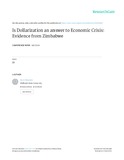Please use this identifier to cite or link to this item:
https://cris.library.msu.ac.zw//handle/11408/1667Full metadata record
| DC Field | Value | Language |
|---|---|---|
| dc.contributor.author | Masunda, Stein | - |
| dc.date.accessioned | 2016-07-08T09:00:49Z | - |
| dc.date.available | 2016-07-08T09:00:49Z | - |
| dc.date.issued | 2016 | - |
| dc.identifier.uri | https://www.researchgate.net/publication/282818160 | - |
| dc.identifier.uri | http://hdl.handle.net/11408/1667 | - |
| dc.description.abstract | This study seeks to establish the role of dollarization as a stabilisation policy in response to economic crises. Using an autoregressive distributed lag model, with data spanning the period 1980 through 2012, findings suggest that dollarization can be used as alternative monetary arrangement for economic stabilization. The results of the study indicate that the mean GDP per capita in the dollarized era is on a high side as compared to the non-dollarized period. More so, past growth contributes positively and significantly to growth in an economy and the contribution declines with space. | en_US |
| dc.language.iso | en | en_US |
| dc.subject | Dollarization, Monetary arrangement, Exchange rate regime, Economic Growth, stabilization | en_US |
| dc.title | Is dollarization an answer to economic crisis: evidence from Zimbabwe | en_US |
| item.fulltext | With Fulltext | - |
| item.languageiso639-1 | en | - |
| item.grantfulltext | open | - |
| Appears in Collections: | Conference Papers | |
Files in This Item:
| File | Description | Size | Format | |
|---|---|---|---|---|
| Is Dollarisation the answer to Economic Crises.pdf | Full Text | 201.37 kB | Adobe PDF |  View/Open |
Page view(s)
152
checked on Apr 4, 2025
Download(s)
82
checked on Apr 4, 2025
Google ScholarTM
Check
Items in MSUIR are protected by copyright, with all rights reserved, unless otherwise indicated.



